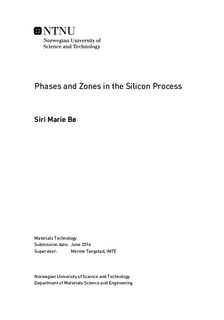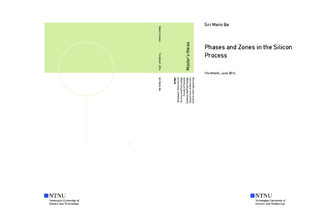| dc.description.abstract | Different zones and materials formed during the production of silicon in a silicon furnace has been examined in this thesis. Samples from two industrial scale silicon furnaces have been have been studied. The excavations were of Wacker furnace 4 and Wacker furnace 1.
Wacker furnace 4 was excavated in August 2015 and samples retrieved are studied to gain a broader understanding of the zones observed by visual inspection of the furnace. Samples were collected from different zones in the furnace.
Wacker furnace 1 was excavated in April 2016. Samples studied were retrieved from areas close to the electrode, from the top of it to the bottom. The main focus was to see how charge materials change along the electrode when moving down in the furnace.
Fissured SiO2 phase is found in samples collected from both Wacker furnace 4 and Wacker furnace 1. They are discussed to be unreacted quartz, condensate or quartz transformed to amorphous phase with some cristobalite. They are concluded to be condensate or transformed quartz, as they are found in high temperatures areas, were softened and melted quartz is assumed to be more smooth.
In Wacker furnace 4, both green and brown condensate is found. It is discussed if the green and brown condensate origins from the same area, where some proba- bly has been moved due to the excavation method. Foamed slag is found near the loose charge and in the middle zone. SiC crust is found on the side of the elec- trode, and in the lower and upper part of the furnace. SiC crust is found in both electrode track zone and middle zone. A SiC/slag-mixture is found at the bottom of the furnace. The slag is mainly gehlenite and anorthrite. It has low viscosity.
In Wacker furnace 1, unreacted charge was found in the pre-reaction area. Un- reacted charge was found down to 1.2 m down in the furnace from the electrode holder. Half converted and fully converted coal to SiC was found 1.5 m from the electrode holder. Condensate with Si in a SiO2-matrix was found 2 m from the electrode holder. Both condensate and SiC crust was found at the bottom of the electrode and in the electrode track zone between electrode 1 and 3. There is found more product of Si underneath the electrode than in the electrode track zone between electrode 1 and 3. This indicates a Si pool.
The materials that make up the zones are different between furnace 4 and 1. This is due to operational history.
The characterization of samples from both furnaces by LOM, EDS, BSD and EPMA are coherent with the first impression and guesstimated characterization of the samples by visual inspection during the excavation.
LOM is a good way to get a preliminary impression of what the sample consists of and how a sample will look in the SEM and EPMA. SEM and EDS is good enough methods for qualitative characterization of phases in a Si furnace. The EDS analysis will be wrong, but consistent for phases of Si and SiC. The problem of carbon coating, making both Si and SiC contain carbon, is solved since the phases will be differed by the amount of carbon found.
Slag samples are hard to analyze and to obtain good qualitative characterization with SEM and EDS. The slag analysis is better by the use of EPMA, but an ap- proximately characterization can be done with the SEM and EDS.
To determine if SiO2 phase found is from condensation or if it is transformed quartz, is hard to do by SEM and EPMA. XRD is proposed as a method for characterization. | |

